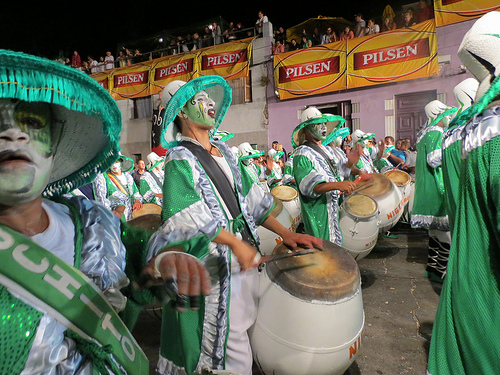Percussionists and dancers in colorful costumes signaled the beginning of carnival during the traditional inaugural parade [1] on January 26, 2012–but carnival in Uruguay is not over yet. The performances and contests that make up the longest carnival in the world will continue well into March.
This, in part, is because carnival in Uruguay involves a lot more than parades. In stages called tablados performers compete in different musical and theatrical categories, like murga [2], negros y lubolos [3] [es] (playing candombe [4]), parodists [5][es] and humorists [6] [es].
As we reported two years ago [7], blogs and websites dedicated to carnival allow people from all over the world to see what Uruguayan carnival is all about. During this time of the year, these sites ramp up their coverage to keep up with the daily events taking place in the country. This year has been no exception.
The site Carnaval del Uruguay [8] [es], for example, provides forums [9] [es] and a chat room [10] [es] where users can discuss different aspects of carnival. The site is also on Facebook [11] [es] and Twitter [12] [es]. Blogs like Uruguay Carnavalero [13] [es] cover the parades and competitions, re-post news, and share important announcements and event schedules. At the same time foreigners and Uruguayans dedicate blog posts to the event, share photos, videos and thoughts on the world’s longest carnival.
This year, Solange González Henott wrote about Uruguay’s carnival in El Blog de la Ruta [15] [es], a travel blog from news site Otramérica.
Cada verano, en medio del Carnaval de Montevideo, el más largo del mundo, el país se envuelve en un torbellino de colores, de humor ácido y del otro, de música, de expresiones culturales propias de los uruguayos y de comparsas de negros y lubolos -blancos disfrazados de negros- en dichas Llamadas.
Solange goes one to explain Llamadas, a parade where Uruguay’s African roots are celebrated to the rhythm of candombe [4]:
Pero de seguro, el momento más esperado son las dos jornadas de competencia que tiran a las calles de los barrios Palermo y Sur, los pasos lentos del esclavo simulado por la cuerda de tambores de las Llamadas, el grupo de músicos que candombean tocando el tambor chico, repique y piano, que guían el baile de el resto de la comparsa en competencia y de todo el público que fielmente, llega cada año a vibrar con los sonidos y el regocijo de ver a las bailarinas y personajes que dan vida a esta gran fiesta del pueblo uruguayo.
Flickr user sfmission of carnaval.com [18] dedicates a set of photos [19], licensed under Creative Commons [20], to the Llamadas parade:
Llamadas means “calls” which was how blacks in Montevideo would meet up for candomble. Calls might be chanting or handclapping but more often it would be drum beats and it meant candomble was about to start.
Many Uruguayans keep up with carnival from abroad, like Leo Bar from the blog Pix in Motion [21]. He writes:
This time of the year, I miss Montevideo the most. The joy of the holiday – Carnaval – the way people forget their worries, party, enjoy life… The colors and sounds can be seen and heard through every neighborhood. A real celebration of culture, roots, friendship and integration.
Leo produced a video titled “Candombe and Llamadas – Carnaval Uruguay,” with video footage of the parades and photos by Flickr user Adriana Cabrera Esteve [22].
You can see a lot more photos of the different events that make up Uruguay's carnival on Carnaval del Uruguay's Facebook page [23].
